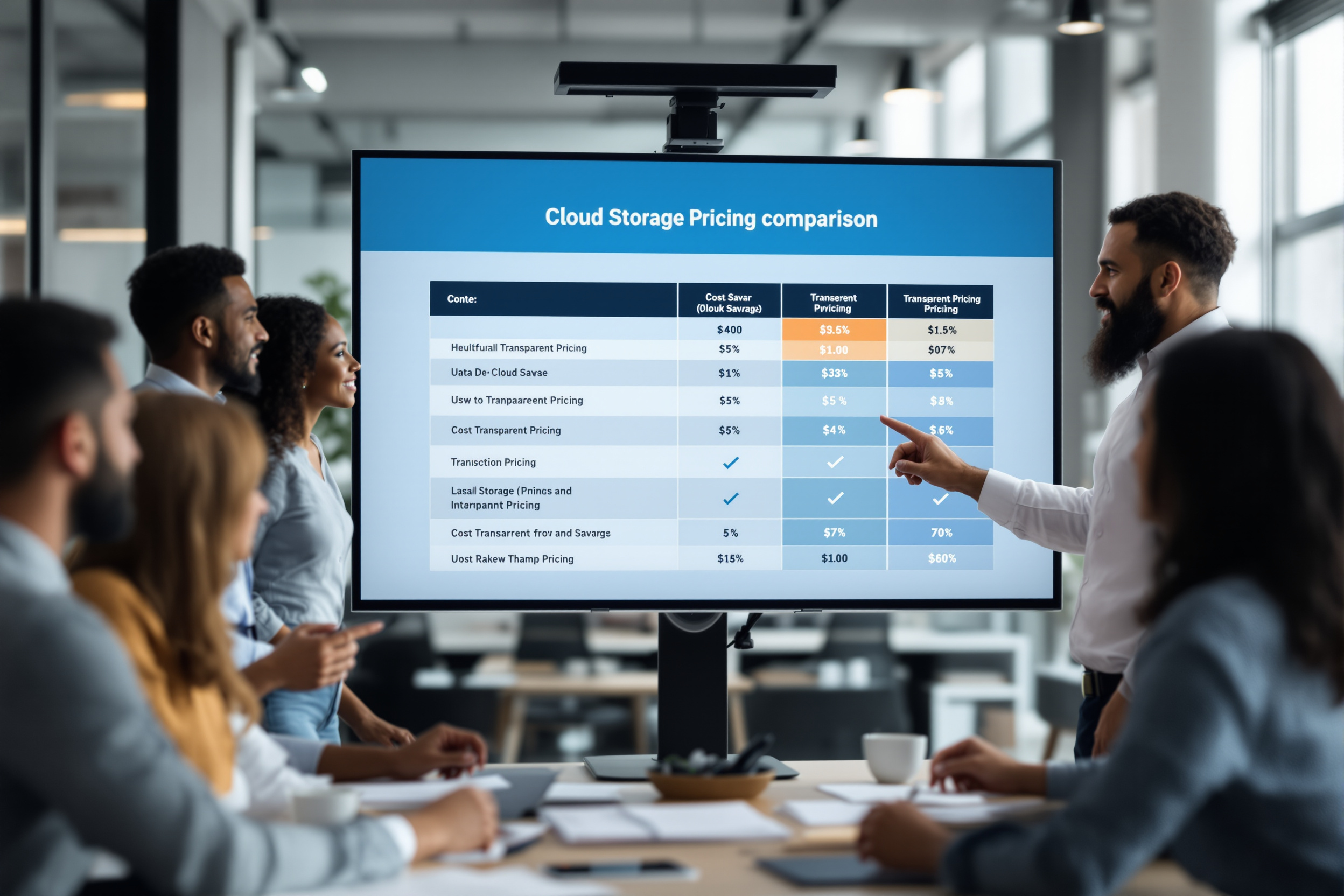Topics on this page
A resilient backup strategy is the foundation of business continuity, yet many organizations struggle with solutions that create more problems than they solve. Unpredictable egress fees, complex pricing, and vendor lock-in make budget planning nearly impossible, with unexpected costs eroding ROI by 10-15% annually. Furthermore, with ransomware attacks increasingly targeting backup infrastructure, legacy approaches are no longer sufficient. A modern backup strategy must deliver not only recovery but also cost predictability, operational simplicity, and a robust defense against evolving cyber threats. This requires a shift to solutions that are cost-efficient by design, fully compatible with existing tools, and provide an exit strategy from day one.
Key Takeaways
- Eliminate unpredictable cloud costs by choosing a backup storage provider with zero egress fees or API call charges, potentially saving 60-80% on your bill.
- Protect your organization from ransomware by making immutable storage (Object Lock) a non-negotiable component of your backup strategy.
- Avoid vendor lock-in and ensure future flexibility by building your backup architecture on fully S3-compatible object storage.
Escape the Hidden Costs of Legacy Backup Models
Cost unpredictability is the number one pain point in cloud storage, with 95% of IT leaders reporting surprise charges that disrupt budgets. These hidden expenses often come from egress fees-charges for moving your own data out of the cloud-which can make up 10-15% of a total cloud bill. This pricing model creates significant financial risk and vendor lock-in, making it prohibitively expensive to switch providers or retrieve large datasets for disaster recovery. A recent survey found that 55% of IT leaders see egress costs as the biggest barrier to switching cloud providers. This forces companies into a corner, limiting flexibility and strategic options. A modern backup strategy must be built on a foundation of economic transparency. By eliminating egress fees and API call charges, organizations can achieve 60-80% cost savings and make budget planning predictable. This financial control is the first step toward a more resilient and independent data protection plan.
Achieve Ransomware Resilience with Immutable Storage
Ransomware attacks increasingly target backup repositories to prevent recovery, making immutable storage a non-negotiable part of any modern defense. Immutability, enabled through features like Object Lock, ensures that once data is written, it cannot be altered or deleted for a predefined period. This creates a secure, unchangeable copy of your data that is impervious to malicious encryption. Even if attackers gain access to your systems, your immutable backups remain safe and recoverable. Many cyber insurance policies now require immutable backups as a condition of coverage, making it a critical compliance component. An effective backup strategy leverages immutability to guarantee that a clean, reliable copy of your data is always available for restoration. This transforms your backup repository from a potential target into your strongest line of defense against ransomware.
Build a Flexible Architecture with S3 Compatibility
Vendor lock-in is a major strategic risk, but a backup strategy built on S3-compatible object storage provides a powerful antidote. The S3 API is the de facto standard for cloud storage, meaning that a vast ecosystem of backup software, archival tools, and applications works with it out of the box. By choosing an S3-compatible alternative, you ensure your existing tools and scripts continue to function without code rewrites. This protects your technology investments and dramatically simplifies migration-often, it's as simple as changing the endpoint in your configuration. This approach gives you the freedom to move data between providers without facing punitive egress fees or technical hurdles, ensuring you retain control over your data and your budget. A truly flexible cloud backup plan depends on this interoperability to avoid dependency on a single provider's proprietary ecosystem.
Accelerate Recovery with an 'Always-Hot' Storage Model
Traditional cloud storage often relies on complex tiering, moving data between 'hot' tiers for frequent access and 'cold' tiers for archiving. While cold storage appears cheaper, it introduces significant delays and costs during data recovery, with retrieval times ranging from minutes to hours. These delays are unacceptable during a critical incident. An 'Always-Hot' storage model eliminates this complexity entirely. All data is immediately accessible without any restore delays or retrieval fees, which can improve backup performance by up to 20%. This simplifies operations, ensures predictable performance for third-party tools, and strengthens your disaster recovery posture. Your backup strategy should prioritize rapid access to ensure business continuity. An always-hot model provides the performance and simplicity needed for fast, reliable restores every time.
Ensure Governance and Compliance with Enterprise-Grade Controls
A modern backup strategy must meet stringent security and compliance requirements, especially for regulated industries. This requires robust identity and access management (IAM) with granular, role-based controls and support for multi-factor authentication (MFA). These features ensure that only authorized personnel can access or manage backup data, a key requirement for SOC 2 compliance. Leading S3-compatible alternatives provide these controls alongside enterprise-grade certifications like SOC 2 and ISO 27001. This verifies that the provider's internal processes for security and availability have been independently audited and validated. When selecting a storage partner, it's critical to confirm they meet these standards. A compliant backup strategy not only protects your data but also simplifies audits and demonstrates a commitment to best-in-class security practices.
A Checklist for Your Modern Backup Strategy
Transitioning to a modern backup strategy requires a clear plan. Use this checklist to ensure your new approach delivers cost savings, resilience, and control:
- Verify True S3 Compatibility: Ensure the solution supports advanced S3 features like Object Lock, versioning, and lifecycle management to guarantee seamless integration with your existing backup tools.
- Eliminate Hidden Fees: Choose a provider with a transparent pricing model that has zero egress fees, no API call charges, and no minimum storage durations. This is the only way to achieve predictable costs.
- Prioritize Immutable Storage: Confirm that Object Lock is available and easy to configure. This is your primary defense against ransomware and should be a mandatory feature.
- Adopt an 'Always-Hot' Model: Avoid complex and slow storage tiers. An always-hot architecture ensures all your backup data is instantly accessible for rapid recovery, reducing your Recovery Time Objective (RTO).
- Confirm Enterprise-Grade Security: Look for essential compliance certifications like SOC 2 and ISO 27001, along with robust IAM controls, to meet regulatory requirements.
- Plan Your Exit Strategy: A modern backup strategy includes portability. By using S3-compatible storage with no egress fees, you ensure you can always move your data freely.
This framework helps you build a resilient and cost-effective data protection plan for the future.
Empowering MSPs with a Predictable Backup-as-a-Service Model
For Managed Service Providers (MSPs), a successful backup strategy hinges on predictable margins and operational efficiency. A storage partner that eliminates egress and API fees is a game-changer for building profitable Backup-as-a-Service (BaaS) and DRaaS offerings. With a predictable cost structure, MSPs can quote with confidence, knowing that surprise bills will not erode their margins by 10% or more. Key features for partners include multi-tenant management consoles with role-based access control (RBAC), automation via API/CLI, and simplified reporting. These tools allow MSPs to onboard new clients quickly and manage multiple environments efficiently. By leveraging a cost-efficient and S3-compatible backend, MSPs can pass savings to customers, increase their own profitability, and deliver a competitive service without the risk of vendor lock-in. This creates a foundation for a scalable and successful channel partnership.
Take Control of Your Backup Strategy Today
Outdated backup strategies create unnecessary risks and unpredictable costs that can strain IT budgets by over 15%. By shifting to a modern, S3-compatible alternative, you can build a resilient, cost-efficient, and flexible backup strategy. Eliminating egress fees, embracing immutable storage, and leveraging an always-hot architecture are the pillars of a plan that delivers both robust protection and financial control. It's time to break free from vendor lock-in and implement a backup strategy designed for the challenges of today and tomorrow. Ready to see how much you could save? Talk to an expert or calculate your savings to discover a better approach to data protection.
More Links
Fraunhofer AISEC discusses cloud security.
Deutsche Bank Research discusses the opportunities and risks of digitalization for small and medium-sized enterprises (SMEs).
FAQ
What defines a modern backup strategy?
A modern backup strategy prioritizes cost predictability, ransomware resilience, and data portability. It is built on S3-compatible object storage with no egress fees, uses immutable storage (Object Lock) to protect against cyber threats, and features an 'always-hot' architecture for rapid data recovery.
How can I reduce my cloud backup costs?
You can reduce cloud backup costs by up to 80% by selecting a storage provider that eliminates unpredictable charges like egress fees and API call costs. Using an S3-compatible platform also allows you to avoid vendor lock-in and choose the most cost-effective solution for your needs.
Is S3-compatible storage secure enough for enterprise backups?
Yes, enterprise-grade S3-compatible storage offers robust security features. Look for solutions that provide multi-layer encryption (in-transit and at-rest), immutable storage with Object Lock, and comprehensive IAM controls with MFA/RBAC. Certifications like SOC 2 and ISO 27001 provide third-party validation of a provider's security posture.
What is 'Always-Hot' storage and why is it better for backups?
'Always-Hot' storage means all your data is immediately accessible without the delays or retrieval fees associated with tiered ('cold') storage. This is better for backups because it ensures you can restore data up to 20% faster during a critical incident, minimizing downtime and operational disruption.
How does this backup strategy help MSPs?
This strategy helps MSPs by providing a predictable cost model with no surprise egress fees, which allows for stable and healthy margins on BaaS and DRaaS offerings. Features like multi-tenant management and automation via API/CLI also simplify operations and speed up client onboarding.
Can I use my existing backup software, like Veeam?
Yes, a key benefit of a backup strategy based on an S3-compatible platform is that it works out-of-the-box with leading backup tools, including Veeam, NovaBackup, and others. You can integrate it into your existing workflows simply by changing the storage endpoint.



.png)
.png)
.png)
.png)



.png)




%201.png)